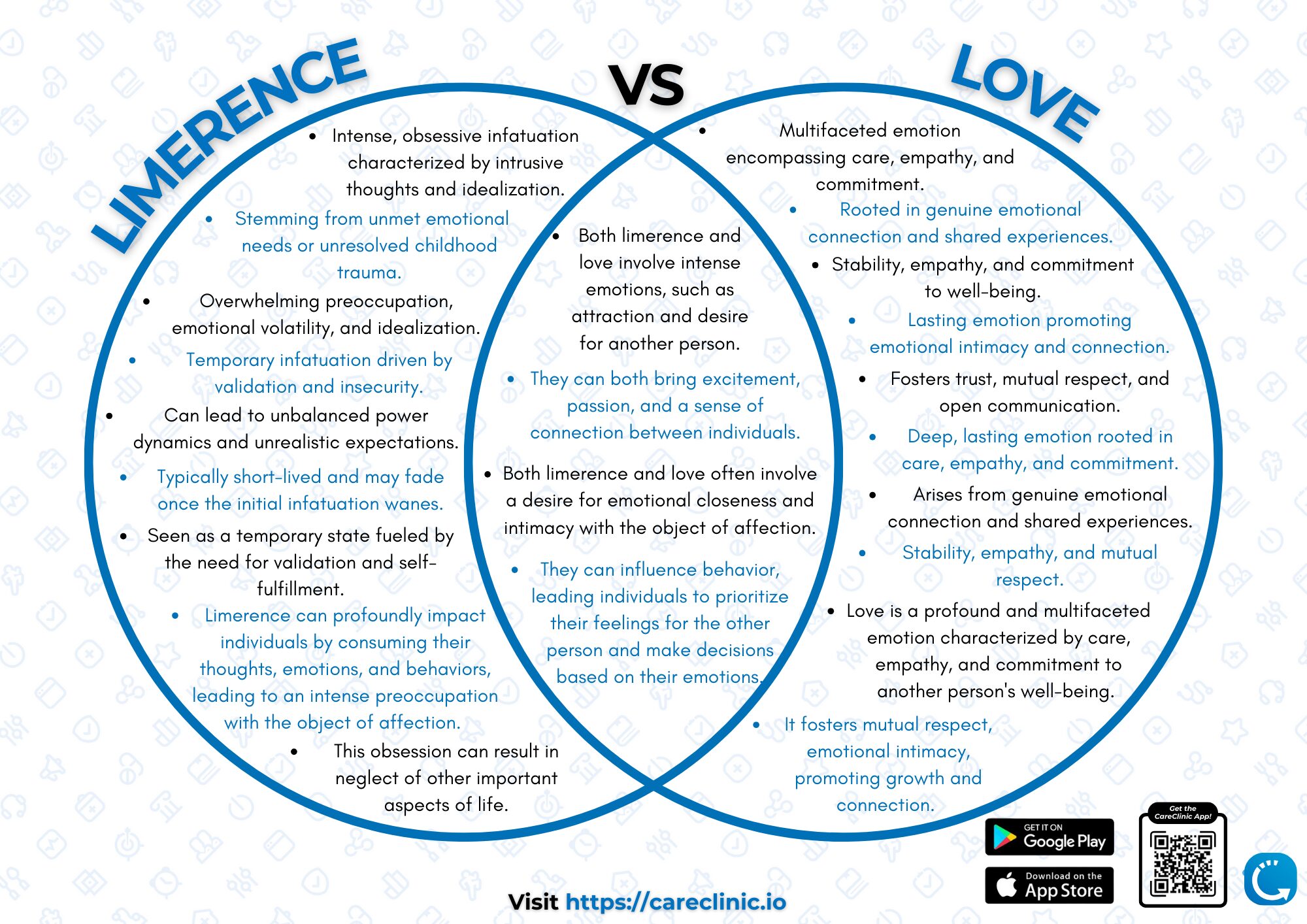
Limerence and love are two powerful emotional roller coaster experiences. It often intertwines and confuses individuals who are in the midst of romantic relationships. To fully comprehend the intricacies of these romantic obsessions, it is essential to distinguish between limerence vs love. As well as understand how each one impacts our lives.
In this article, we will break down the differences between limerence vs love. Exploring their definitions, origins, characteristics, and psychological perspectives. Additionally, we will delve into the impact of a limerent relationship. As well as discuss strategies for transitioning from limerence to emotional turmoil.
Defining Limerence
Limerence can be defined as an intense, obsessive infatuation with another person. Characterized by intrusive thoughts, fantasizing, intense longing, and idealization. Unlike love, which tends to build over time. Limerence is often sudden and all-consuming.
The origin of limerence can typically be traced back to mental health, a person’s flaws, unmet emotional needs, or unresolved childhood trauma. Causing a limerent person to seek validation and fulfillment through an intense attachment to another individual’s own life. Understanding how to manage and cope with limerence is essential for those experiencing these intense feelings.
The Origin of Limerence
Limerence is believed to stem from a combination of biological, psychological, and environmental factors. Early experiences and attachments in childhood play a crucial role in shaping an individual’s capacity for limerence.
For example, a person who has inconsistent or emotionally distant caregivers may develop a heightened desire for connection and intense emotional dependency in adulthood.
Key Characteristics of Limerence
Several key characteristics distinguish limerence from love. Firstly, limerence is often marked by an overwhelming preoccupation with the object of affection. This leads to a constant desire for reciprocation and validation. Additionally, limerence is associated with heightened emotional volatility. As well as a tendency to idealize the other person while disregarding their flaws or negative traits. This amalgamation of emotions can create an intense rollercoaster of feelings.
Understanding these emotional patterns takes time and self-awareness. If you want to learn about limerence and how it affects your relationships, recognizing these intense feelings is the first step. Many people find that tracking their emotional responses helps them see the difference between healthy attraction and obsessive thoughts.
Which can be both exhilarating and mentally exhausting.
The Psychological Perspective on Limerence
 From a psychological standpoint, limerence is viewed as a temporary state of infatuation that can be distinguished from lasting love. Psychologists believe that while limerence may ignite a passionate attraction, it is ultimately unsatisfying in the long term. This is because limerence is primarily fueled by the desire for validation and the need to alleviate internal insecurities, rather than genuine emotional intimacy and connection.
From a psychological standpoint, limerence is viewed as a temporary state of infatuation that can be distinguished from lasting love. Psychologists believe that while limerence may ignite a passionate attraction, it is ultimately unsatisfying in the long term. This is because limerence is primarily fueled by the desire for validation and the need to alleviate internal insecurities, rather than genuine emotional intimacy and connection.
Furthermore, research suggests that limerence can have a profound impact on an individual’s mental and emotional well-being. The intense focus on the object of affection can lead to a neglect of other important aspects of life, such as work, friendships, and personal goals.
This tunnel vision can drain your emotional energy in ways you might not realize. When you’re constantly thinking about someone, it uses up mental resources you need for daily tasks. Learning what is spoon theory can help you understand how emotional stress affects your energy levels throughout the day.
This tunnel vision can result in a sense of imbalance and a loss of self-identity.
Moreover, limerence can also have physiological effects on the body. When experiencing limerence, the brain releases a surge of neurotransmitters, including dopamine, norepinephrine, and serotonin. These chemicals create a euphoric feeling, similar to the rush of a drug, which can be highly addictive. As a result, individuals in a state of limerence may find it challenging to break free from the cycle of obsession and longing.
Understanding Love
While limerence may be an intense infatuation, love is a multifaceted emotion that encompasses a range of experiences and behaviors. Love can be classified into different types, such as romantic love, familial love, or platonic love, each with its unique characteristics and dynamics. Unlike limerence, which is often transient, love has the potential to deepen and evolve as individuals develop emotional intimacy and through shared life experiences.
The Many Facets of Love
Love can manifest in various ways, depending on the context and the individuals involved. Romantic love, for example, is often characterized by passion, attraction, and a desire for physical and emotional closeness. On the other hand, familial love is rooted in a sense of responsibility, care, and support within a family unit. Exploring these different facets of love can provide a deeper understanding of the complex nature of this profound emotion.
The Biological Basis of Love
Love has a biological basis, with the release of certain chemicals such as oxytocin and dopamine playing a significant role in facilitating emotional bonding and attachment. These chemicals contribute to feelings of happiness, pleasure, and a sense of security when individuals are in the presence of their loved ones. Furthermore, love has been linked to various health benefits, such as reduced stress levels and improved overall well-being.
Love in Different Cultures
 Love is a universal emotion, but its expression and cultural significance can vary across different societies. Cultural norms, beliefs, and traditions shape the way love is experienced and understood. For example, in some cultures, arranged marriages are the norm, where long-term commitment and compatibility are valued over temporary infatuation.
Love is a universal emotion, but its expression and cultural significance can vary across different societies. Cultural norms, beliefs, and traditions shape the way love is experienced and understood. For example, in some cultures, arranged marriages are the norm, where long-term commitment and compatibility are valued over temporary infatuation.
In addition to cultural variations, historical and societal factors can also influence love. For instance, in ancient Greece, love was celebrated as a divine force and was extensively explored in literature and art. The concept of “eros,” representing passionate and romantic love, was highly revered and was considered an essential part of human existence.
Furthermore, social and economic factors can influence love. In some societies, love is shaped by social status, wealth, or power dynamics. Marriages are often arranged to strengthen family alliances or to secure financial stability. The dynamics of love relationships can be shaped by these external factors, adding additional layers of complexity to the experience.
Comparing Limerence and Love
While limerence and love may share some similarities, they are fundamentally distinct experiences. Understanding the differences between limerence and love can shed light on the nature of our emotions and help us navigate our relationships more effectively.
Delving deeper into the realm of emotions, it’s fascinating to explore how limerence and love manifest in our lives and impact our relationships. The intricate dance between these two intense emotions shapes the way we perceive others and ourselves, influencing our actions and decisions.
Similarities Between Limerence and Love
Both limerence and love involve intense feelings of attraction and desire for another person. They can both bring excitement, passion, and a sense of connection. However, limerence is often characterized by an obsessive fixation on the object of affection, whereas love promotes a more balanced and stable emotional connection.
Peeling back the layers of these emotions reveals a complex tapestry of human experiences. The euphoria of limerence and the depth of love intertwine to create a rich emotional landscape that shapes our relationships in profound ways. It’s this intricate interplay that adds depth and complexity to our understanding of human connections.
Differences Between Limerence and Love
The key distinction between limerence and love lies in their longevity and the underlying motivations driving these emotions. Limerence is typically short-lived and driven by the need for validation and self-fulfillment. In contrast, love is a deeper, lasting emotion that involves genuine care, empathy, and a commitment to the well-being of the other person.
Exploring the roots of these emotions uncovers a fascinating journey of self-discovery and personal growth. While limerence may offer a temporary escape into a world of fantasy and desire, love provides a sturdy foundation for building meaningful and lasting connections with others. It’s this enduring quality of love that sustains us through life’s challenges and enriches our existence in ways that limerence alone cannot.
The Impact of Limerence and Love on Relationships
Both limerence and love can have profound effects on our relationships, shaping the dynamics and outcomes of romantic connections.
Understanding the complexities of human emotions is essential in navigating the intricate landscape of relationships. Limerence, often characterized by intense infatuation and obsession, can cloud judgment and lead individuals to make decisions based on fleeting emotions rather than rational thinking. This heightened state of emotional arousal can create a sense of euphoria but may also result in impulsive actions that can strain the bond between partners.
How Limerence Affects Relationships
Limerence can exert significant influence over our behaviors and decisions in relationships. When experiencing limerence, individuals may prioritize their own emotional needs and desires over the well-being of their partner. This can lead to unbalanced power dynamics, unrealistic expectations, and an inability to form healthy, sustainable connections. Recognizing limerence is crucial to prevent it from negatively impacting our relationships.
Moreover, limerence can blur the lines between fantasy and reality, creating an idealized image of the object of affection. This idealization can set unrealistic standards for the relationship, making it challenging for both partners to maintain a sense of authenticity and genuine connection. It is important for individuals to differentiate between limerence and genuine love to cultivate meaningful and lasting relationships.
The Role of Love in Healthy Relationships
In stark contrast to limerence, love plays a pivotal role in fostering healthy, satisfying relationships. Love promotes emotional intimacy, trust, and mutual respect between partners. It encourages open communication, empathy, and a genuine commitment to the happiness and growth of the relationship. Nurturing love in our relationships requires ongoing effort, understanding, and a willingness to prioritize the well-being of both ourselves and our partners.
True love involves a deep sense of connection that goes beyond surface-level infatuation. It is rooted in acceptance, support, and a shared vision for the future. Love empowers individuals to weather the storms of life together, offering a sense of security and companionship that transcends the initial stages of passion. Cultivating a foundation of love in a relationship requires patience, empathy, and a willingness to embrace both the joys and challenges that come with genuine emotional investment.
Moving from Limerence to Love
 Recognizing and transitioning from limerence to love is a significant step towards building fulfilling and long-lasting relationships. Here are some strategies to help navigate this process:
Recognizing and transitioning from limerence to love is a significant step towards building fulfilling and long-lasting relationships. Here are some strategies to help navigate this process:
- Self-reflection: Take the time to reflect on your emotions and motivations. Understanding why you are drawn to a person can help distinguish between limerence and genuine love.
- Realistic expectations: Recognize that nobody is perfect. Accepting both your own and your partner’s flaws and imperfections is essential for fostering genuine love.
- Building emotional connection: Focus on developing emotional intimacy and genuine connection. Encourage open and honest communication, and actively work towards understanding and supporting each other.
- Prioritizing mutual growth: Foster an environment that promotes personal growth and supports each other’s dreams and aspirations. Healthy relationships are built on individual growth and mutual support.
Recognizing Limerence: Overcoming Limerence
Identifying limerence can be challenging, especially when it is fueled by intense emotions and infatuation. However, being aware of the signs of limerence, such as obsessive thoughts, idealization, and an all-consuming desire for reciprocation, can help prevent it from negatively shaping our relationships.
Transitioning from Limerence to Love
Transitioning from limerence to love requires time, self-reflection, and a willingness to let go of unrealistic expectations. By working on developing a genuine emotional connection, focusing on mutual growth, and prioritizing the well-being of both yourself and your partner, you can gradually transition from the intensity of limerence to the depth and stability of love.
Understanding the difference between limerence and love is crucial for navigating the complexities of romantic relationships. While limerence may initially draw us in with its intensity and infatuation, love provides the foundation for lasting emotional connections. By recognizing the distinction between these two emotions and actively working towards fostering love, we can cultivate relationships that are built on trust, empathy, and mutual support.
Use the CareClinic App to Keep Track of Intense Infatuation
Embark on your journey from limerence to love with the CareClinic App, a comprehensive tool designed to help you manage and reflect on your emotional well-being. By tracking your mood, thoughts, and relationship dynamics, the app provides valuable insights into your emotional patterns and helps you identify the transition from limerence to love.
The CareClinic App’s features, such as daily mood tracking and journaling, allow you to monitor the evolution of your feelings, fostering self-awareness and emotional growth.
Download the CareClinic App and Monitor Intense Feelings
Utilize the CareClinic App to set personal goals and reminders for nurturing your relationships. Ensure that you prioritize emotional intimacy and mutual support. With the app’s ability to track progress and reflect on your journey, you can work towards developing a deeper, more stable connection with your partner.
Install the App today and take the first step towards transforming the intensity of limerence into the enduring strength of love.
When obsessive thoughts about someone take over your mind, it can feel impossible to break free. You can learn about limerence and discover ways to manage these overwhelming feelings. Simple techniques help you regain control when your thoughts spiral out of control.



